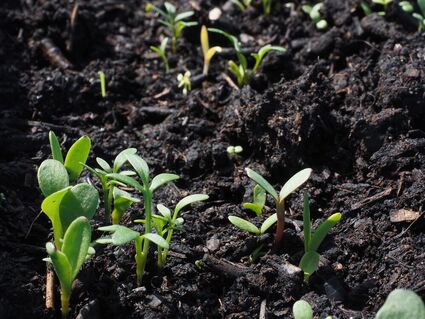Improving Soil: Always Begin with a Test
Last updated 4/26/2022 at 6:06pm
As many of you may already know our soil in Southeast Texas, or more specifically in Jefferson and Orange County is not optimum for most plants and can be difficult to cultivate. Clay soil is a challenge for both you and your plants. Heavy clay soil drains slowly, and it retains moisture longer and when it finally does dry out, it is hard and brittle with a cracked surface. Our soil type is known as Coast Prairie Soil.
So, you might ask what is needed to improve clay soil, and where do I begin? Creating good soil is a process which takes time, requiring soil amendments which help to loosen the soil, free up nutrients yet retain moisture. How do you know which soil amendments are needed? The process always begins with a test, pH and soil analysis! This is the crucial first step to improving clay soil.
Soil Analysis-purchase a home pH test kit or send a soil sample to Texas A&M AgriLife for testing, either way the cost is minimal. The County Extension office has forms with instructions for capturing soil samples. Afterward, you will receive a detailed report in approximately two weeks. The results provided from Texas A&M AgriLife will be detailed providing you with exact information on what is needed to amend your soil unlike the at home pH test kit which provides more generic soil corrections. For most plants, the ideal pH range is 6.2 – 7.0.
Organic Matter-helps to improve drainage and soil structure by lighten heavy clay soil. Additionally, it provides beneficial nutrients which feed microorganisms in the soil, thus improving the soil. Typically, adding aged manure and compost is completed in spring before planting. This is accomplished by incorporating a 2 to 3-inch layer of amendments by working into the soil at shovel depth. Continue adding organic matter throughout the season, such as shredded leaves, grass clippings, or additional compost.
Raised Beds-building elevated structures or raised beds can greatly assist with drainage. A raised beds can be a simple mound of soil such as in a conventional vegetable garden, or it can be elevated from ground level and constructed of wood, brick, stone, or many different materials. When constructing a raised bed, ensure the beds' size (width) is such that you can reach the middle from either side. If you decide to utilize a raised bed, do not use soil from an area of your landscape as this will defeat the purpose of building the raised bed. Be sure to good quality garden soil, compost, and aged manure.
Mulch Beds-over winter. Winter is now a faded memory for us but even so, remember this fall is to mulch beds. By leaving them bare, rain will compact the soil, which makes it harder to work the soil in spring. Any mulch will work! Mulching helps keep weed growth to a minimum during winter. In spring, simply remove the mulch placing it on garden paths, as it may not have decomposed enough to be worked into the soil. Remember earth worms are garden friends and rototilling destroys their habitat.
Expanded Shale-is a common sedimentary rock that comprised of flakes of clay and other minerals such as quartz and calcite. Expanded shale is also found in Texas, from a time when Texas was an enormous lakebed. It is a lightweight, gray, porous gravel and closely related to perlite and vermiculite. By adding it to heavy clay soil, it lightens and aerates the soil but can also hold 40% of its weight in water allowing. Note expanded shale does not breakdown readily, meaning clay soil will remain stay loose for many years once incorporated into the soil.
Greensand-is an organic fertilizer containing mineral deposits from the ocean floor. It enhances soil structure allowing for increased root growth and excellent for overall plant health by providing needed nutrients. Greensand isn't water soluble, so it needs to be incorporated into the soil at a rate of 30lbs per 1000 feet.
If you have specific gardening questions or need more information, contact the Orange County Master Gardeners Helpline: (409) 882-7010 or visit our website: https://txmg.org/orange, Facebook: Orange County Texas Master Gardeners Association or Email: [email protected].






Reader Comments(0)